Tropical Fruit in a Can: Exotic Delights!
Canned tropical fruits are a practical choice for those seeking the exotic flavors of the tropics at any time of the year.
These canned varieties preserve the taste and nutritional benefits, including essential vitamins and antioxidants, making them a healthy addition to any diet.
This article provides insights into the advantages of canned tropical fruits, how they maintain their nutritional value, and tips for selection, storage, and culinary uses.
Canned tropical fruits undergo a preservation process that involves sealing them in airtight containers, often with added syrup or juice, and then heat sterilizing them to kill any bacteria and enzymes that could lead to spoilage.
This process helps in retaining much of the fruit’s nutrients.
Here are key points to consider:
Explore the tropical allure with canned fruits that offer a delightful mix of convenience, nutrition, and year-round availability in just one bite.
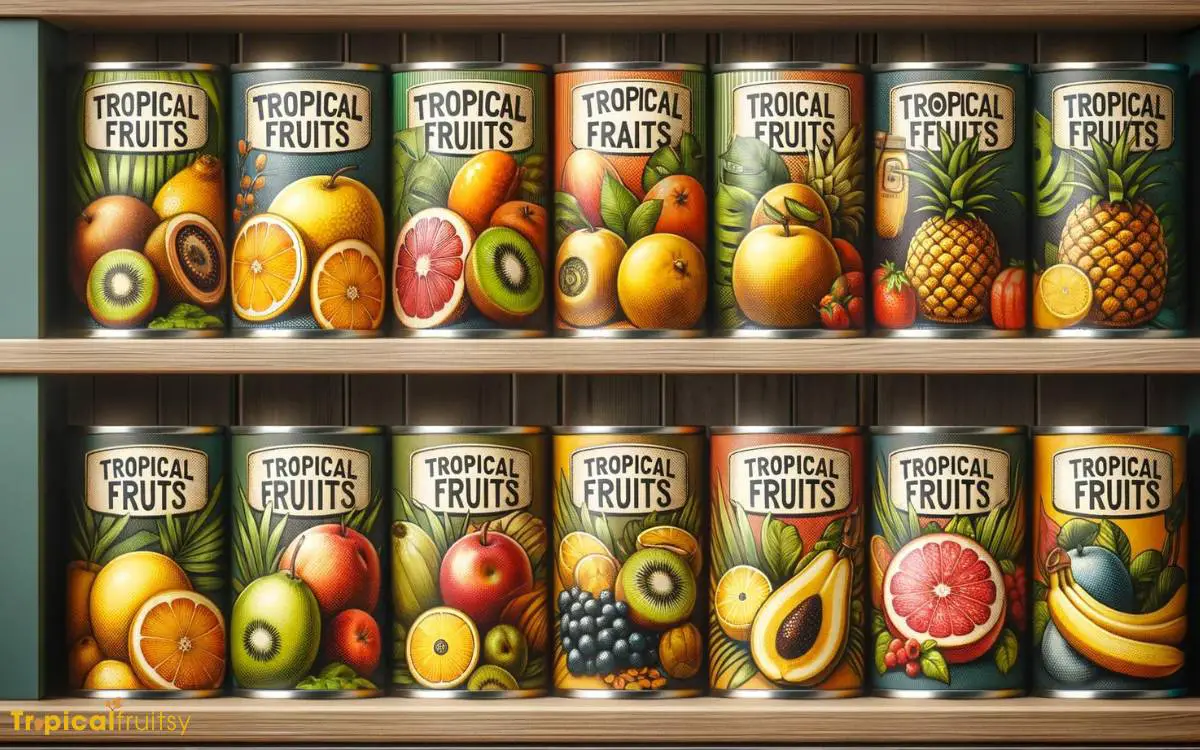
Key Takeaway
Tropical Fruit Profiles
| Fruit Type | Description | Nutritional Benefits | Common Uses |
|---|---|---|---|
| Pineapple | Sweet and tangy, rich in vitamin C | Immune support, antioxidant properties | Baking, toppings, smoothies |
| Mango | Juicy and flavorful, high in vitamin A | Vision health, skin health | Desserts, salsas, salads |
| Papaya | Soft, buttery texture, contains papain enzyme | Digestive aid, anti-inflammatory | Breakfast bowls, marinades |
| Lychee | Exotic and perfumed, source of vitamin B | Energy production, brain health | Cocktails, desserts, snacks |
The Allure of Canned Tropicals
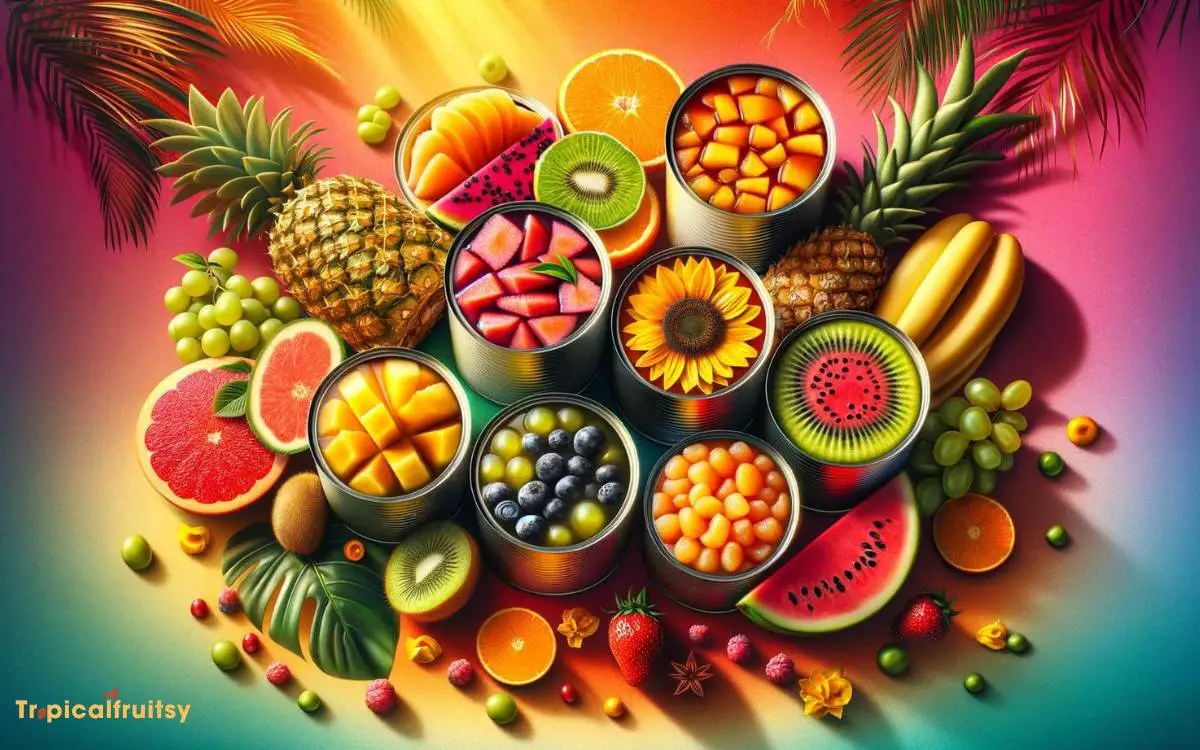
Why do consumers find canned tropical fruits an appealing alternative to their fresh counterparts?
The preference for canned tropical fruits can be attributed to several factors that are analyzed from a technical viewpoint.
One primary consideration is the extended shelf life that canning imparts, which circumvents the rapid perishability common to tropical fruits.
This process, involving pasteurization and hermetic sealing, significantly retards microbial growth and enzymatic activity, preserving the fruit’s nutritional value and taste over time.
Additionally, the convenience of pre-cut and ready-to-eat portions caters to the fast-paced lifestyle of many consumers, eliminating the need for laborious peeling and cutting.
Moreover, canned fruits offer year-round availability, transcending seasonal limitations and geographical constraints, thereby providing consistent access to exotic flavors regardless of the consumer’s location.
Nutritional Benefits Unpacked
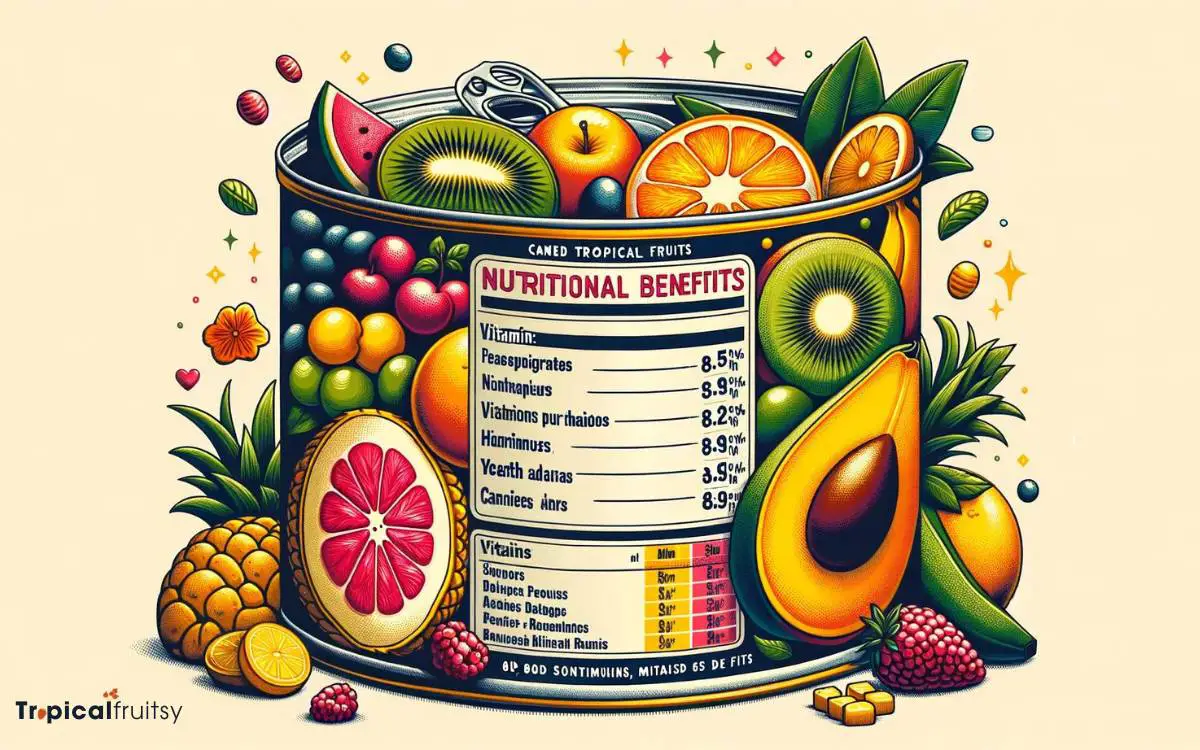
Canned tropical fruits provide a convenient source of vitamins, often retaining a significant portion of their original nutrient profile through the canning process.
The preservation techniques employed ensure that dietary fiber, crucial for digestive health, remains intact within the fruit.
This discussion will examine the efficacy of canning methods in maintaining these nutritional benefits, focusing on the stability of vitamin content and fiber during processing and storage.
Vitamin Content Retention
Although many consumers opt for fresh fruit, canned tropical fruits can retain a significant portion of their vitamin content when processed and stored properly.
The canning process involves heating the fruits to destroy microorganisms, which can also lead to the degradation of some heat-sensitive vitamins such as vitamin C and certain B vitamins.
However, once canned, the fruits are less exposed to oxygen and light, which can further degrade vitamins over time in fresh fruit. Vitamins A and E, which are more stable, can be preserved well in canned products.
Additionally, water-soluble vitamins tend to leach into the canning syrup or juice, but these nutrients are not lost if the liquid is consumed.
With the advancements in canning technology, the focus on preserving nutritional value has led to improved methods that maintain a higher level of vitamin content.
Fiber Preservation Process
Turning now to the fiber content, the canning process typically maintains the dietary fiber found in tropical fruits, which is crucial for digestive health and maintaining a balanced diet.
The preservation of fiber is paramount since it plays a significant role in modulating the body’s use of sugars, helping to keep hunger and blood sugar in check.
Analyzing the canning process reveals that while some water-soluble nutrients may leach into the canning liquid, insoluble fiber is not significantly affected.
This is crucial given that a high-fiber diet has been associated with numerous health benefits, including a lower risk of developing heart disease, stroke, hypertension, diabetes, obesity, and certain gastrointestinal diseases.
| Fruit | Fiber (grams per serving) |
|---|---|
| Pineapple | 1.4 |
| Mango | 2.6 |
| Papaya | 2.5 |
| Lychee | 1.3 |
| Guava | 5.4 |
Selection and Storage Tips
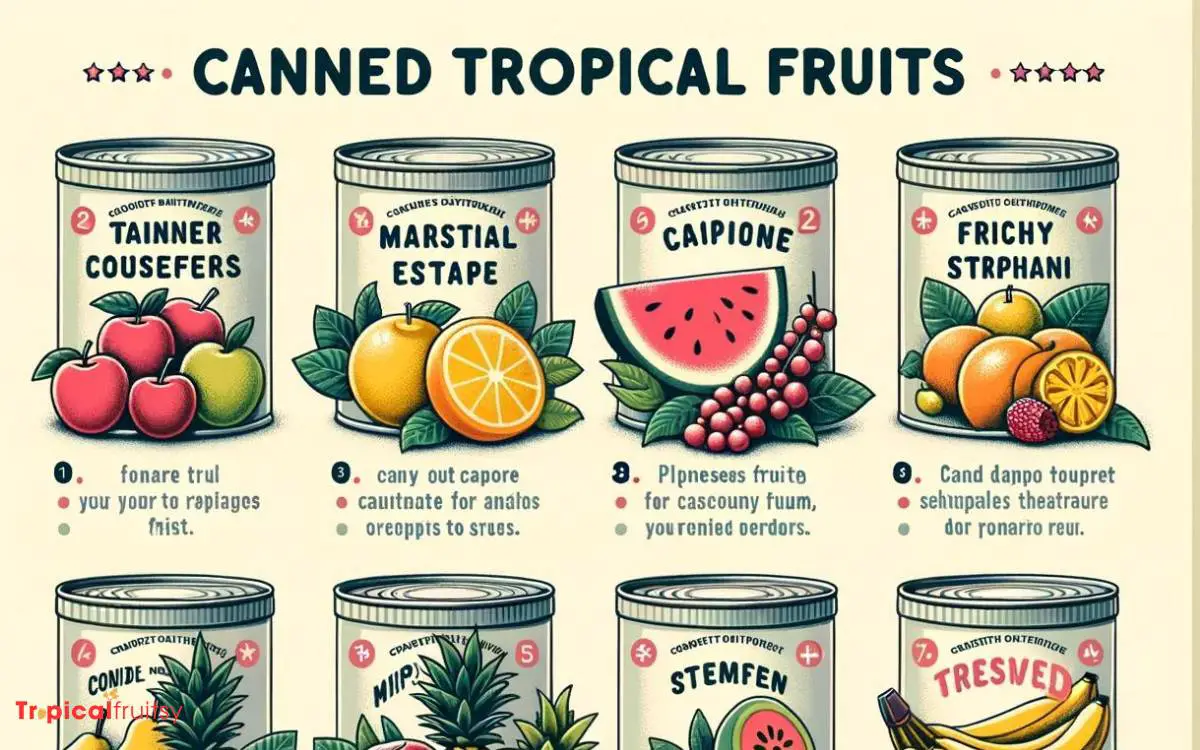
While choosing canned tropical fruit, it is essential to examine the expiration date and integrity of the can to ensure freshness and safety.
Consumers must scrutinize cans for dents, rust, or swelling, which can indicate compromised quality or potential contamination.
It is advised to select cans that have a clear label indicating the contents, packing liquid, and nutritional information, ensuring transparency and traceability.
Upon purchase, canned fruits should be stored in a cool, dry place away from direct sunlight to maintain their quality and extend shelf life.
Regular rotation based on the ‘first in, first out’ principle minimizes the risk of exceeding the ‘best by’ date.
Now, let’s consider the various culinary uses and recipes that can be enhanced by the inclusion of canned tropical fruits.
Culinary Uses and Recipes

Incorporating canned tropical fruits into recipes can effortlessly elevate the flavor profile of both savory and sweet dishes.
These preserved delights offer a consistent quality and year-round availability that fresh counterparts might not always provide.
For instance, canned mangoes can be pureed and incorporated into a mango vinaigrette, delivering a tangy-sweet complexity to salads.
Similarly, canned pineapple chunks might be added to stir-fries, lending a caramelized sweetness that balances spicy elements.
Chefs often deploy canned tropical fruits in desserts, such as pineapple upside-down cakes or mango-infused cheesecakes, capitalizing on their inherent syrupy glaze and tender texture.
The versatility of these fruits extends to beverage applications, including smoothies and cocktails, where they contribute concentrated flavors.
Quality and Sustainability

The integration of eco-friendly packaging solutions in canned tropical fruit production not only reflects corporate responsibility but also appeals to environmentally conscious consumers.
Maintaining a consistent flavor profile is crucial for consumer satisfaction and brand loyalty, thus necessitating advanced preservation technologies that safeguard the fruits’ taste and nutritional value post-harvest.
These dual objectives of sustainability and quality assurance represent pivotal challenges for the industry, requiring meticulous attention to material sourcing, manufacturing processes, and quality control measures.
Eco-Friendly Packaging
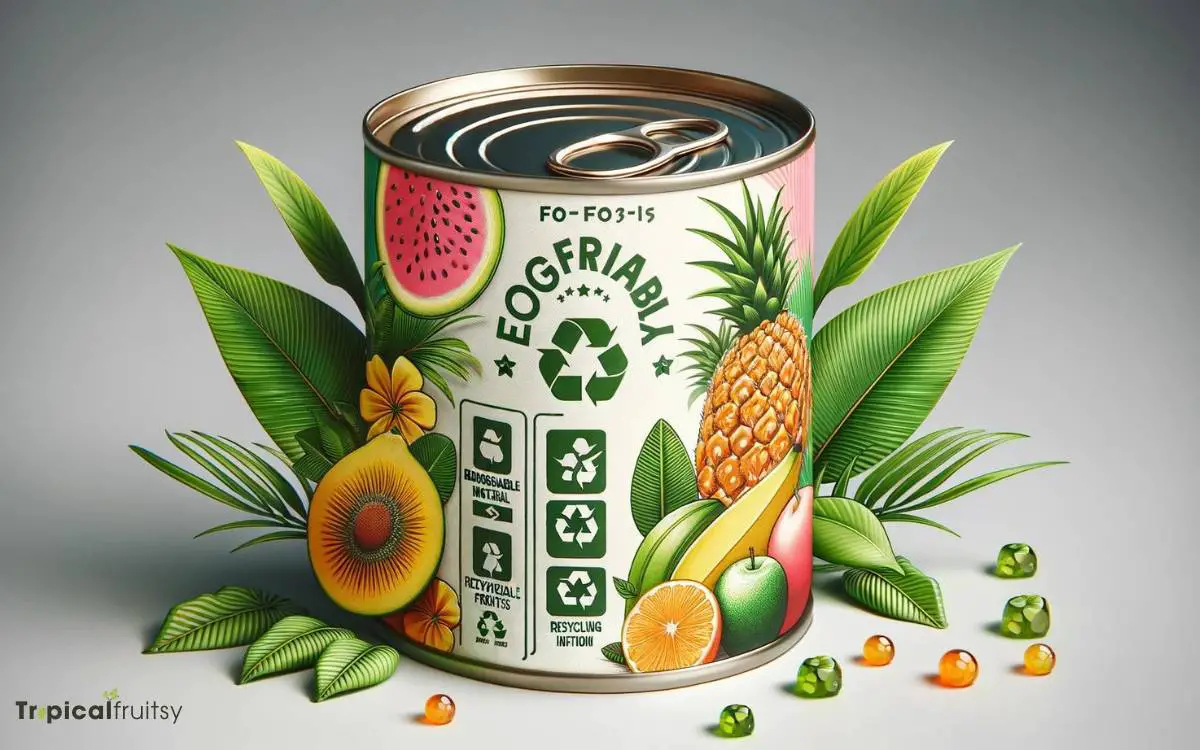
Emphasizing sustainability, manufacturers are increasingly adopting eco-friendly packaging for canned tropical fruits to minimize environmental impact.
This strategic shift not only reflects corporate responsibility but also aligns with consumer expectations for sustainable practices.
The following measures are representative of this trend:
- Utilization of recyclable materials, such as aluminum and steel, which offer high recovery rates and energy-efficient recycling processes.
- Reduction in packaging weight to lower transportation emissions, optimizing logistics and reducing the overall carbon footprint.
- Implementation of biodegradable liners inside cans to prevent corrosion while maintaining the integrity of the product.
- Adoption of renewable materials for labeling, which further reduces the reliance on non-renewable resources.
These initiatives are critical in ensuring product quality, as well as environmental stewardship. This approach dovetails into the next consideration: consistent flavor retention.
Consistent Flavor Retention
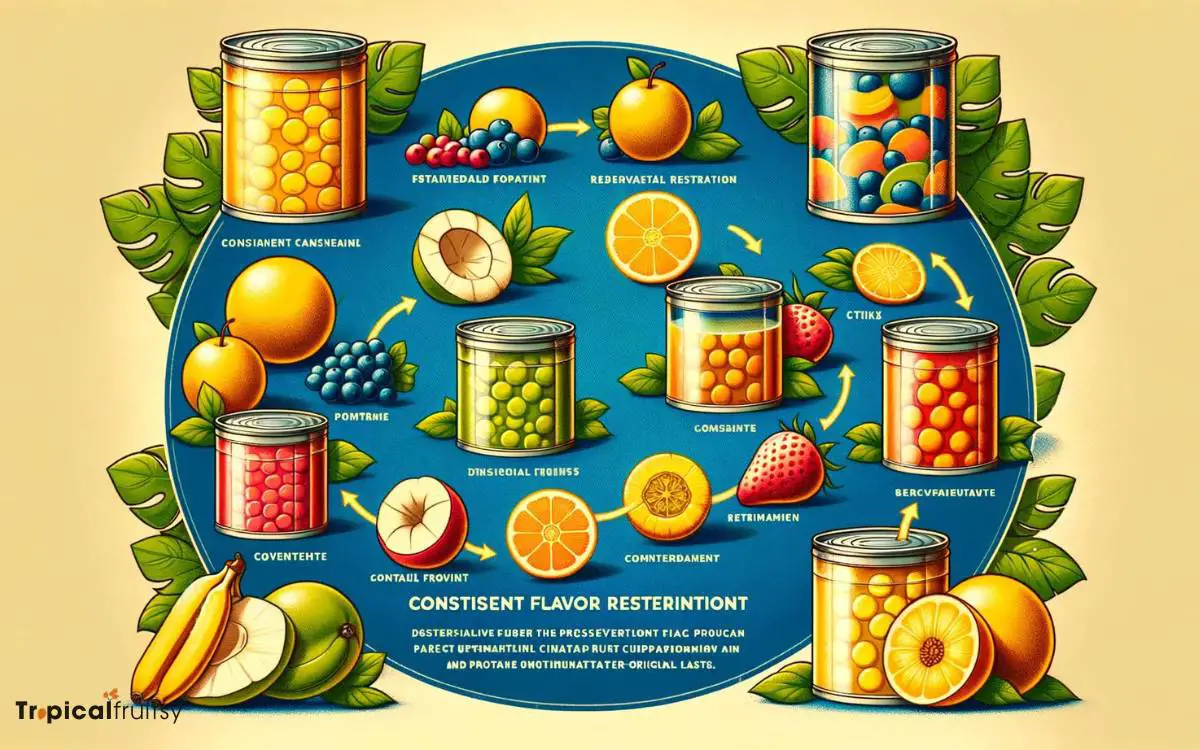
Beyond the adoption of eco-friendly packaging, ensuring the consistent flavor retention of canned tropical fruits is paramount for manufacturers to maintain quality while fulfilling sustainability commitments.
This crucial aspect hinges on the meticulous control of processing parameters, such as pH adjustment, syrup concentration, and thermal treatment.
Manufacturers must leverage advanced food science techniques to inhibit enzymatic degradation and microbial growth, two factors that can significantly alter flavor profiles over time.
By employing high-precision canning processes, the integrity of the fruit’s organoleptic properties can be preserved.
Furthermore, the industry must continuously explore innovative preservation methods that minimize the use of additives while maximizing natural taste, thus aligning with sustainable practices and consumer preferences for clean label products.
Creative Serving Suggestions
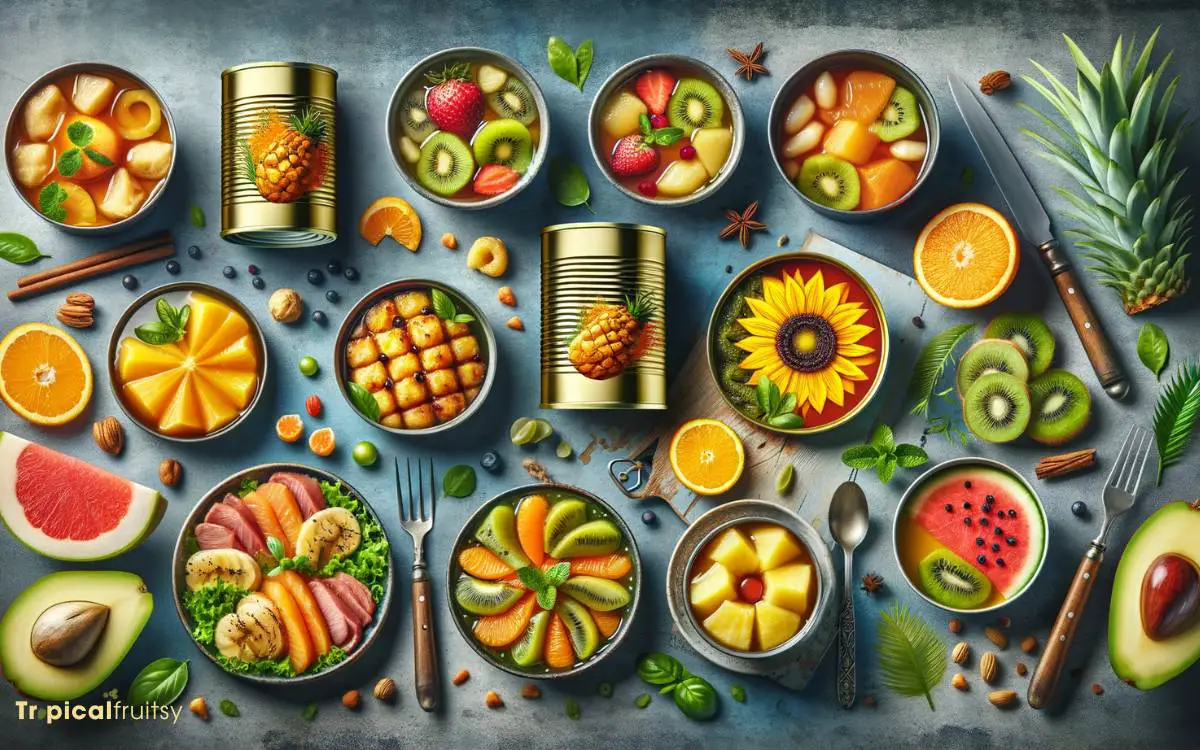
Frequently, chefs elevate the presentation and taste of canned tropical fruits by incorporating them into exotic salads, decadent desserts, and refreshing beverages. The versatility of these preserved delicacies allows for innovative culinary expressions.
To maximize the gastronomic potential of canned tropical fruits, consider the following serving suggestions:
- Layer mango slices with creamy coconut rice pudding, garnishing with a sprinkle of toasted sesame seeds for a textured contrast.
- Incorporate pineapple chunks into a vibrant salsa, paired meticulously with grilled fish or jerk chicken to balance the flavors.
- Blend papaya puree into smoothies or cocktail bases, exploiting its natural sweetness and smooth texture.
- Craft a tropical fruit compote, gently spiced with star anise and cinnamon, to accompany artisanal cheeses or to elevate a simple yogurt parfait.
These applications not only showcase the fruits’ adaptability but also debunk common misconceptions about their utility and flavor profile, which will be further explored in the next section.
What are the Best Ways to Enjoy Tropical Fruit from a Can?
When it comes to tropical fruit taste exploration from a can, there are several ways to enjoy these delicious treats. You can blend them into smoothies, pair them with yogurt, or even use them in dessert recipes. The convenience of canned tropical fruits makes it easy to add a taste of the tropics to any dish.
Common Myths Debunked
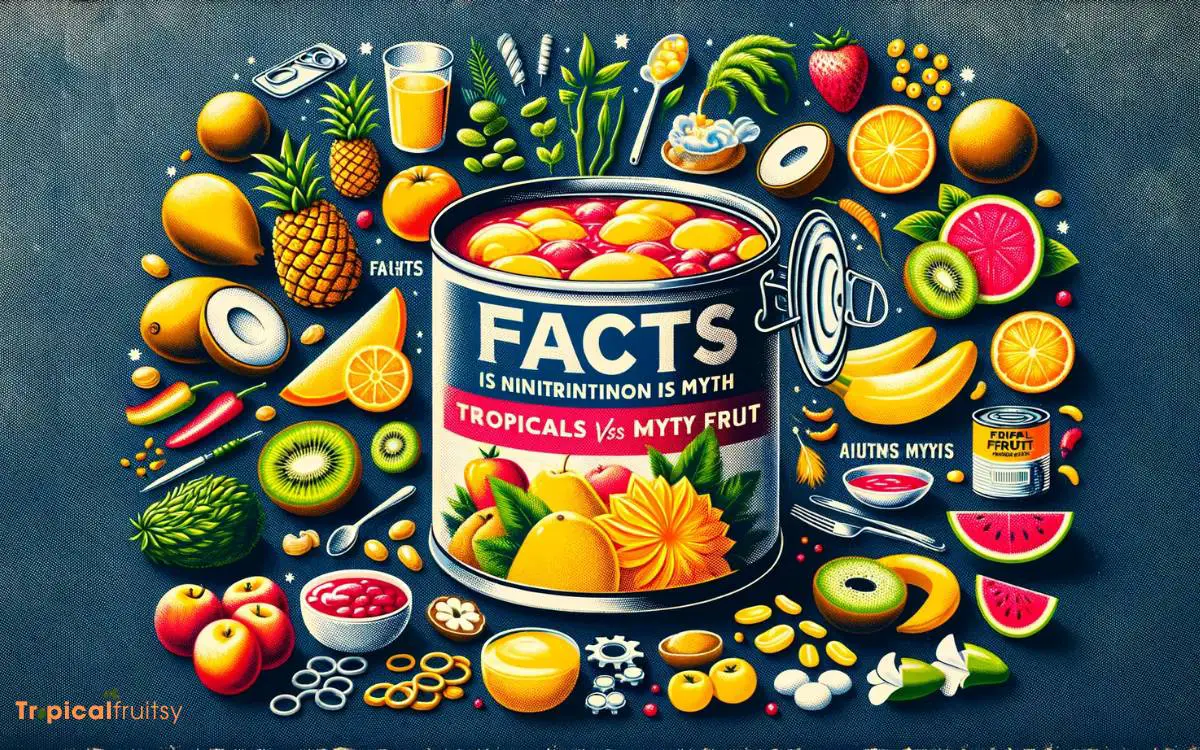
Misconceptions surrounding canned tropical fruits often lead to underutilization in culinary practices, despite their versatility and robust flavor.
A prevailing myth is that canning process significantly diminishes the nutritional value of fruits. However, studies indicate that while certain heat-sensitive vitamins may be reduced during canning, other nutrients can become more bioavailable.
Another common fallacy suggests that canned fruits are saturated with preservatives, which is not the case as the canning process itself acts as a preservative by eliminating microorganisms through sterilization.
Furthermore, the belief that canned fruits are laden with added sugars is not universally accurate. Many options are packed in their own juices or water, offering health-conscious consumers alternative choices.
Dispelling these myths is essential for recognizing the practical benefits of incorporating canned tropical fruits into a balanced diet.
Conclusion
In the pantheon of convenience and nutrition, canned tropical fruits hold their own.
The analysis reveals that, when quality and sustainability are prioritized, these preserved treasures offer not only a tapestry of flavors for the culinary artist but also a repository of nutrients for the health-conscious.
As Odysseus was drawn to the Sirens’ call, so too might consumers be enticed by the harmonious blend of practicality and tropical indulgence that canned fruits provide.






